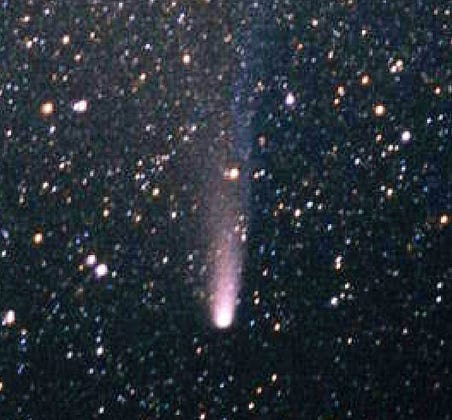
A BRIEF HISTORY OF HALLEY’S COMET
Revised extracts from A Comet Called Halley by Ian Ridpath
(Cambridge University Press, 1985)
Cometary fireworks
Cometary fireworks
Even if you never view Halley’s Comet itself, you can see bits of it twice every year, in May and October. At those times, the Earth shoulders its way past the trail of dust laid by the Comet on its travels around the Sun, and on each occasion astronomers go out to watch a shower of shooting stars.
A shooting star – really no star at all – is a brief flash of light caused by a speck of cometary dust burning up high in the atmosphere. Astronomers term them meteors. Watch for an hour on any clear night and you will see a few stray meteors, long since separated from their parent comets, plunging to their fiery deaths 100 kilometres above your head. But several times a year the Earth passes close to a comet’s orbit, and encounters a dust storm that produces a celestial firework display known as a meteor shower.
Dust spread along the orbit of Halley’s Comet causes two meteor showers each year: one in the third week of October, when we pass 23 million kilometres from the inbound leg of the Comet’s orbit, and the other in the first week of May, when we pass 10 million kilometres from its outbound track. The May shower is called the Eta Aquariids, because the dust trails appear to radiate from near the star Eta Aquarii, while the October shower is the Orionids, which seemingly originate from the constellation Orion.
To an astronomer, a ‘shower’ means perhaps one bright meteor every five minutes, so do not expect the see the heavens falling. We merely dip into the outskirts of the Halley dust trail, so its fireworks are not as spectacular as the displays caused by other comets during the year. ☄